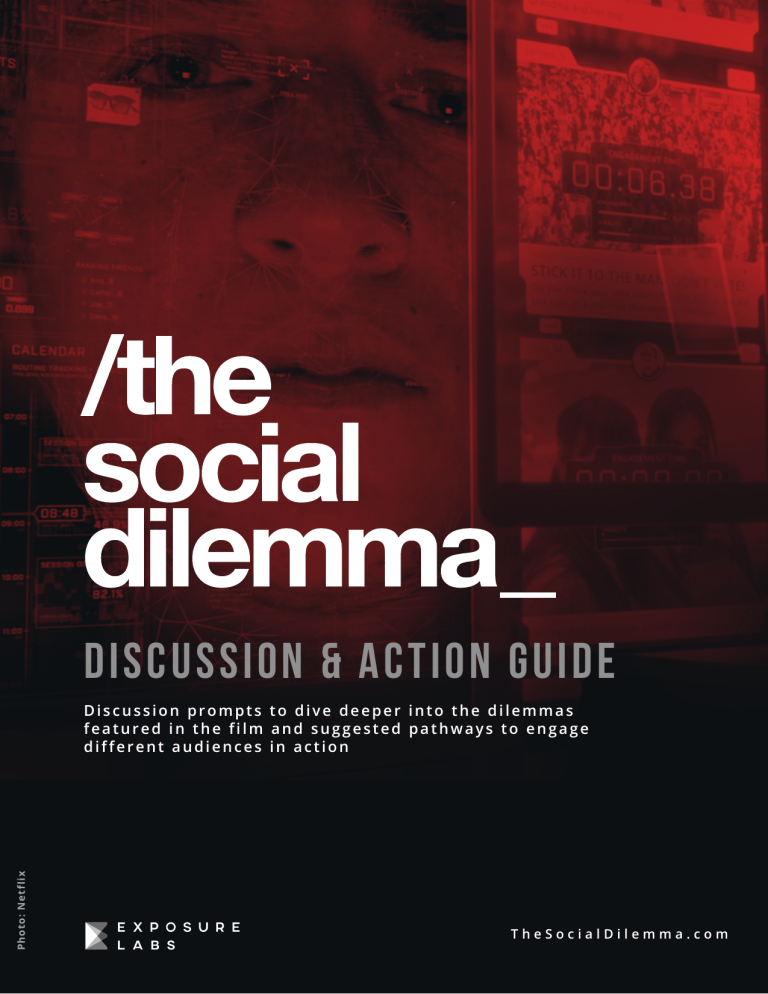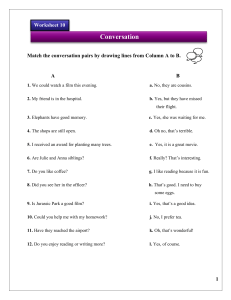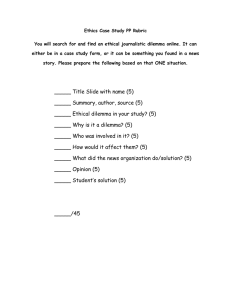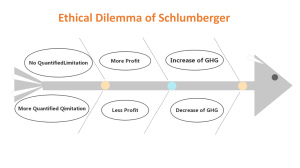
Discussion & Action Guide Photo: Netf lix Discussion prompts to dive deeper into the dilemmas featured in the film and suggested pathways to engage different audiences in action TheSocialDilemma.com TABLE OF CONTENTS 1. introduction Why Lead a Conversation Tips for Facilitating a Constructive Conversation 2. Part I. General Discussion Guide: Understanding the Dilemma The Dilemma The Way Forward 3. Part II. Audience Series: Your Role In the Solution Families Students & Teachers Technology Workers Advertisers Looking for technical tips to plan and promote your event? Check out our planning guide. introduction Why Lead a Conversation Exploitative technology was able to proliferate due to a lack of collective understanding around how these platforms work and how they impact us. COVID-19 has pushed us indoors, away from each other, and online more than ever. It has also spotlighted our increasing reliance on technology that is often at odds with the public good. Bringing humanity back to tech requires one human at a time talking about how to change that. Early social media “growth hackers” discovered that getting new users to 7 friends in 10 days could help them reach unprecedented scale. This same principle can be applied to fixing the problem. Hosting a conversation with just a few people can ignite a global movement to align technology with the interests of people, not profits. We need trusted community leaders like you to create space for people to grapple with our current reality, reflect on their roles, and be a part of the solution. To help facilitate a productive conversation, we’ve segmented this guide into two sections – each complete with quick facts, discussion questions, and ways to take action. What you’ll find: Part I General Discussion Guide: Understanding the Dilemma Questions for all audiences to help participants examine the cause of the dilemma, recognize its harms, and take action. Part II Audience Series: Your Role In the Solution Hosting a conversation with just a few people can ignite a global movement to align technology with the interests of people, not profits. Questions for certain audiences – students, families, technology workers and advertisers – to examine the unique roles they have in both perpetuating and solving the problem. 3 // Discussion and Action Guide Tips for Facilitating a Constructive Conversation 1. Take a moment after the film. If your group is viewing The Social Dilemma right before the discussion, pause between. When the discussion begins, invite attendees to share initial reactions and emotions before diving into specific questions. 2. Set expectations. We recommend establishing the Chatham House Rule, which allows participants to share thoughts and stories from discussions outside the “room” as long as everyone’s identity and affiliation are kept anonymous. You might also set other norms, such as creating a judgement-free zone so people feel safe to freely express their experiences and opinions. 3. Keep the conversation focused. Your role as a moderator means ensuring everyone feels heard. If a few people begin dominating the conversation, draw others in by calling on names or changing the format of how people answer questions. If you have a larger groups (e.g., more than 10), consider breaking the conversation into smaller groups. Zoom breakout rooms are a great way to do this. 4. 5. 4 // Encourage participants to personalize, specify and stay engaged. Ask the group to ground what they’re saying in personal experience or anecdotes from the film rather than broad, abstract statements. Allow attendees to disagree and explain why so they can learn from each other’s perspectives, but steer them away from debating or negative judgments. If anyone seems uncomfortable or frustrated, encourage them to take a moment but not drop out of the conversation. Embrace complexity and collective responsibility. Rather than villainizing one single source that lets everyone else “off the hook,” focus the conversation on the agency – whatever that scale may be – of those in the discussion. 6. Connect the dots to your community. As you hear people expressing common problems, relate them to key terms and issues in the film as well as what’s going on in the world and in your community right now. Pose rhetorical questions like: “Why does this matter [in LOCATION or to AUDIENCE/GROUP]?” You might also consider focusing on just one of the three dilemmas on the next page to tailor the discussion to your audience. 7. Enjoy yourself. Treat this conversation as a positive opportunity to discuss how we live our lives and spend our time, and welcome laughter and commiseration. 8. End on a hopeful note. Hope is a powerful motivator. Close with a vision for more humane technology and the feasible steps your community can take to get there. Discussion and Action Guide Part I General Discussion Guide: Understanding the Dilemma The Dilemma The companies that connected the world and transformed how we consume information did so at a cost. The unintended consequences of exploitative technologies are catching up with us in the form of: /the mental health dilemma_ Addiction, anxiety and depression. Platforms are designed to reward distraction and keep us hooked – at the expense of our wellbeing – to fuel their business. /the democracy dilemma_ Political polarization and divisiveness. Content that promotes outrage, deception, and conspiracy is promoted as a way to drive more engagement. Stronger ideological rifts make cooperation and compromise increasingly difficult and ultimately sabotage our democracy. /the discrimination dilemma_ Algorithmic bias and the amplification of hate. Algorithms are not equipped to detect hate speech and the data harnessed by our online activity is used by institutions in ways that can harm and discriminate against marginalized communities. Photo: iStock / William Perugini Those of us who rely on these platforms are unknowingly complicit in this devil’s bargain, where we trade our freedom for followers, our social cohesion for instant connection, and the truth for what we want to hear. 6 // Looking for more information? Check out our FAQs for our team’s answers to common questions about the issue and key concepts referenced throughout the film. Discussion and Action Guide Conversation starters 7 // • So, how would you define the problem? • As film subject Shoshana Zuboff points out, extractive technology has made internet companies “the richest companies in the history of humanity.” How would you define their business model? What are they selling? Have you (or someone you know) experienced negative consequences as a result? • What do you think are the foreseeable threats that exploitative and extractive technologies pose to our society? • Film subject Tristan Harris says, “If something is a tool, it genuinely is just sitting there, waiting patiently [to be used]. If something is not a tool, it’s demanding things from you, it’s seducing you, it’s manipulating you. It wants things from you.” Do you think social media is a tool for you? How might you make it one? • Who do you think is responsible for solving “the social dilemma”? What should they do? Is there anything you can do? Discussion and Action Guide /the mental health dilemma_ Addiction, anxiety and depression. Platforms are designed to reward distraction and keep us hooked – at the expense of our wellbeing – to fuel their business. fast facts • A third of American adults – and nearly half of those ages 18-29 – say they are online “almost constantly.” [Pew Research Center, 2019] • Teenagers who spend 3 hours/day or more on devices are 35% more likely, and those who spend five hours or more are 71% more likely, to have a risk factor for suicide than those who spend less than one hour. [iGen, 2017] • A 5,000 person study found that higher social media use correlated with selfreported declines in mental and physical health and life satisfaction. [American Journal of Epidemiology, February 2017] Discussion questions • Do you find yourself unconsciously checking your phone or certain apps? Did this – or the impulse to – happen at all while watching the fim? What emotions seem to trigger this behavior? • What kinds of emotional responses do you have to the content in your feed? What content tends to have a negative impact on your well-being? How often do you see it? • Film subject Tristan Harris posits that before artificial intelligence overpowers human strength, it will “overpower human weakness.” What does he mean by that? In what ways do you think technology has overpowered your own vulnerabilities? How is it shaping your behaviors day-to-day? Register your event with us and get access to an exclusive bonus clip for The Mental Health Dilemma featuring additional commentary from our film subjects. 8 // Discussion and Action Guide /the democracy dilemma_ Political polarization and divisiveness. Content that promotes outrage, deception, and conspiracy is promoted as a way to drive more engagement. Stronger ideological rifts make cooperation and compromise increasingly difficult and ultimately sabotage our democracy. fast facts • Fake news spreads 6x faster than accurate news on Twitter, and falsehoods are 70% more likely to be retweeted. [MIT, 2018] • The # of countries with political disinformation campaigns on social media doubled in the past 2 years. [New York Times, 2019] • Google search results can shift the voting preferences of undecided voters by 20% or more — up to 80% among some demographics. [PNAS, 2015] • An internal memo to Facebook senior executives in 2018, which was largely ignored, read, “Our algorithms exploit the human brain’s attraction to divisiveness. If left unchecked, [they’ll feed users] more and more divisive content in an effort to gain user attention & increase time on the platform.” [WSJ, 2020] Discussion questions • Film subject Justin Rosenstein says, “You look over at the other [political] side, and you start to think, ‘How can those people be so stupid? Look at all of this information that I’m constantly seeing. How are they not seeing that same information?’ And the answer is: they are not seeing that same information.” Do you think it’s important for everyone to have the same set of facts? Do you follow people and sources you disagree with? Why or why not? • Film subjects Aza Raskin and Renée DiResta have written that there’s “a difference between freedom of speech and freedom of reach.” What do you think they mean by that? • Should all – or any – ideas be amplified by algorithms? Should the same standards be used for individuals as for public figures or advertisers? Who should decide? Register your event with us and get access to an exclusive bonus clip for The Democracy Dilemma featuring additional commentary from our film subjects. 9 // Discussion and Action Guide /the discrimination dilemma_ Algorithmic bias and the amplification of hate. Algorithms are not equipped to detect hate speech and the data harnessed by our online activity is used by institutions in ways that can harm and discriminate against marginalized communities. fast facts • Researchers found that leading AI models for processing hate speech were 1.5x times more likely to flag tweets as offensive or hateful when they were written by African Americans. [University of Washington, 2019] • 64% of the people who joined extremist groups on Facebook did so because their algorithms steered them there. [Internal Facebook Report, 2018] • Until 2019, Facebook allowed advertisers to use discriminatory targeting in ads: those advertising jobs, housing, and credit offers, could choose to exclude people on the basis of gender, race, disability and other characteristics, in direct contravention of federal laws such as the Fair Housing Act, which bans discrimination. [Washington Post, 2019] Discussion questions • Should we trust an algorithm to make major decisions such as employment, financial, or housing outcomes as well as what information we see? Is it possible for algorithms to be objective when they are written by humans – mostly white upper class Americans in Silicon Valley – who are shaped by their own biases and experiences? • Are there ways that the use of your online data might contribute to institutions discriminating against you? How might this kind of behavior disproportionately impact marginalized communities? • Do you think algorithms that prioritize outrageous and divisive content amplify hate toward minority groups? What should be done? Register your event with us and get access to an exclusive bonus clip for The Discriminarion Dilemma featuring additional commentary from our film subjects. 10 // Discussion and Action Guide The Way Forward “ As long as social media companies profit from outrage, confusion, addiction, and depression, our well-being and democracy will continue to be at risk. It’s time to change that. – Center for Humane Technology Technology has become such an integral part of our lives that it can be easy to think that these systems simply cannot change. This is a false illusion. These platforms were created by people, so it is fully within our power to change them. But we can’t rely on those who created the problem to fix it. We need to hear from and deeply involve others, including those the problem impacts most. A more humane future will require fundamental changes to how our society designs, regulates and uses technology. To undo the side effects of extractive technology, we need to: • Design// Diversify the tech talent pipeline, center the experiences of vulnerable populations, and design our technology as tools to serve human strengths rather than manipulate human weaknesses. • Regulation// Adopt safeguards that limit harm to individuals and drive greater accountability between creators and users. • Use// Shift cultural norms and individual behaviors in ways that promote a positive, constructive relationship with technology and our devices. Will you join the movement? Now that you’ve reflected on the various dilemmas that have emerged from the current model, we invite you to explore the many ways you can take action on our Take Action page or dive into Part II on the next page for ways you can take action based on your role in the solution as a family member, student, technologist or advertiser. 11 // Discussion and Action Guide Part II Audience Series: Your Role In the Solution Families fast facts Discussion questions • 50% of teens report feeling “addicted” to their phones – as do 27% of parents. [Common Sense Media, May 2016] • The average American child receives his/her first smartphone at age 10 [CQ Researcher, 2016] • 88% of teens who use social media have witnessed others being cruel online. Children who are cyberbullied are 3x more likely to engage in suicidal ideation than non-bullied children. [Pew Research Center, May 2018; JAMA Pediatric, May 2014] • In desperation, the family in the film uses a Kitchen Safe™ to lock up their screens, but this solution is short-lived. What is your family’s relationship with your devices and social media at home? Were there any moments between the film’s fictional family that felt particularly resonant? • Do you notice a link between your use of certain technologies and how you feel, or the quality of your relationships, especially during COVID-19? • Do you want to use your phone and/ or social media less? Should your family have any rules around how and when you’re using your devices? What are some ways you might try to disconnect or focus usage on meaningful connection? • What are some concrete actions major tech companies could take to better protect children and preserve your family’s time and connection? take action • Consider creating a Family Media Agreement to establish shared practices for your tech usage in your house. • Use Mozilla’s Data Detox x Youth kit to make you or your child’s online experience safer and more secure. • If you or someone you know is experiencing anxiety, depression or suicidal thoughts, contact a licensed therapist or The National Alliance on Mental Health’s hotline here. 13 // Discussion and Action Guide Students & Teachers fast facts Discussion questions • Teens use entertainment screen media • The algorithm showed Ben various things, for an average of nearly 7.5 hours a day – not including the time they spend using screens for school or homework. [Common Sense Media, 2019] like his ex-girlfriend and propaganda from the Extreme Center, that it thought he would like to keep him on his phone. What does the algorithm show you? Is this information useful, or do you feel like it is manipulating your time and attention? • As teens’ time on social media specifically has gone up, so have their depression rates. One study found that, between 2009 and 2017, rates of depression among kids ages 14 to 17 increased by more than 60%. [ Journal of Abnormal Psychology, 2019] • 80% of students mistake “sponsored content” ads for legitimate news. [NPR, Stanford, 2016] take action • From what sources do you and your friends typically get news and information? Do these feel trustworthy? How do you know that is the case? • Do you feel that your school promotes positive uses of technology, especially with so much instruction taking place online now? Are there any norms or rules in place around how technology is used? What new norms might you consider introducing and sharing with your administration? • Tech art critique: Select a tech-related artwork from high school library media specialist Kristen Mattson’s Discussion Cards to consider as a class, or break students into groups to discuss and present on different pieces. • Digital Citizenship Curriculum: Help students take ownership of their digital lives with Common Sense Media’s K–12 Digital Citizenship Curriculum. The curriculum will support students in developing digital citizenship skills to participate fully in their communities and make smart choices online and in life. Topics include media balance, cyberbullying, news and media literacy, online privacy, digital footprint, and communication. 14 // Discussion and Action Guide Technology Workers fast facts Discussion questions • 22% of Facebook employees surveyed disagree or strongly disagree with the statement, “My company believes customer data protection is a top priority.” [Team Blind, 2019] • Government regulation is the preferred mechanism among tech workers to address the consequences of extractive technology. But almost half of people in tech (45%) believe their sector is currently regulated too little. [DotEveryone, 2019] • Only 19% of the general public believes that tech companies are designing their products and services with people’s best interests in mind. [DotEveryone, 2019] • As a technology worker, what is your social dilemma? What is the most concerning or urgent part of the problem to you? • The film encourages the general public and regulators to put pressure on the economic models underlying much of the tech industry. Do you agree that the business model needs to change? How can that happen? • What are some of the alternative models these platforms could have pursued as they grew? Do you see an opportunity in the market for these alternatives now? • What role can people like you play in creating and demanding humane technology solutions from within your organization or among your peers in the industry? take action • Sign up for the Center for Humane Technology’s course for tech leaders who want to explore with their peers how to build technology that can have a positive impact on human minds, relationships, and society. • Join an upcoming conversation hosted by the Center for Humane Technology to share challenges and learnings with other practitioners committed to building more humane tech solutions 15 // Discussion and Action Guide Advertisers fast facts Discussion questions • 3/4 of Facebook users are unaware that it keeps lists of their personal interests, such as their political leanings, for advertisers. [Pew Research Center, January 2019] • 50% of Americans who looked at their ad preferences on Facebook said they were uncomfortable with the company creating these lists about them. [Pew Research Center, January 2019] • 17% of Americans believe personalized ads are ethical. [RSA Data Privacy & Security Survey: 2019] • Online advertisers have the ability to target and influence the masses to an unprecedented degree. Do you believe advertisers should have that kind of power? • Are you or your clients concerned about your ads appearing alongside misinformation or hate speech on social media content? Is this something you think platforms and publishers should provide more control and transparency around? • What role can advertisers play in prioritizing humane ad solutions and pushing platforms and publishers to make change? take action • Share the film with 7 coworkers or other online marketers in the next 10 days and talk about your role in shifting the business model away from distraction and manipulation. • Discuss how your organization can put in place a plan to shift your advertising strategy to one that relies less on data surveillance. [You might start with Harvard Business Review’s article, “Ads That Don’t Overstep”]. • Join the Stop Hate for Profit coalition to send a message that you will not use advertising platforms that monetize harmful content. 16 // Discussion and Action Guide





